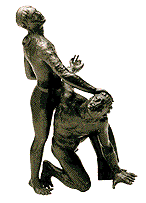Invited
to China by the Emperor Wu of the Liang dynasty (about A.D. 520), he traveled
there, where he undertook the form of mediation known as 'nine years facing
the wall' at shaolin-szu. Having founded the Zen sect (A.D. 557) at the
age of seventy-six, he taught his disciples the arts of the preservation
of health, the eighteen ways of Lo-han, the I-hu ching, and the Hsi-sui
ching, all of which had a marked influence on Chinese theories of fighting
methods. Chinese-style wrestling is called Chiao Ti Shu, or in Japanese,
Kakuteijitsu.
During
the so-called 'Spring-Autumn period' (770-481 B.C.), and the period of
civil wars (480-222 B.C.) the various arts of fighting, among which was
the popular Kakuteijitsu, were highly valued among the noble classes in
China. During the Tsin (221-207 B.C.) and the Han dynasties (208-206 B.C.)
the Chinese emperors, particularly Shia Huang Ti (the first Tsin Emperor)
and the Han Emperor Liang Wu Ti patronized Kakuteijitsu, which soon spread
among the military and the people, as a sport, with the result that techniques
were gradually improved.
Kakuteijitsu
in the Han period became known as Kaiko. In 1558 a Chinese names Ch'en
Yuan Yun went over to Japan and lived at Shokokuji in Edo (now Tokyo),
where he initiated the Japanese into the mysteries of Kakuteijitsu.
Today
Kaiko is chiefly popular in Po Ting, in Ho Buk province, and it is known
as Hotei (Po Ting) Kaiko (K'uai Chiao). When the Mongols invaded China
during the Yue period (1206-1368), they brought with them Mongolian wrestling,
and this form of athletic art mingled with Kakuteijitsu and eventually
became widespread. During the Ming dynasty (1368-1644), however,
people came to value technique and speed, and to despise mere physical
strength, which the Mongols, on the other hand, emphasized.
Although
there are various Oriental martial arts, such as jujitsu, fighting with
sword or spear, archery, or dueling with cudgels, the basis of them all
is the same as that of Karate: Karate is the most basic of all the martial
arts, for it teaches fighting with no more weapons than a man is born
with, and follows the teaching of emptiness as in Zen Buddhism.
It
is evident that Sumo was originally a form of combat with no holds barred,
fought until one opponent knocked down the other, like the Chinese Kakuteijitsu
and Greek Pankration. For example, it is recorded that in the Yamato
period, Nomino Sukune and Taimano Kehaya wrestled in the presence of the
Emperor Suinin, and Sukune broke one of Kehaya's ribs and his hip-bone
by kicking, and then stamped him to death. However, such techniques
as punching, striking, and kicking were forbidden during the Naro period.
Sumo has become a sport rather than a martial art in earnest. Today, Sumo
is a Japanese national sport, and is very popular among both professionals
and amateurs.
